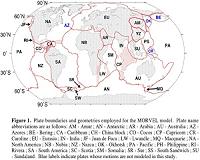| . |  |
. |
Ann Arbor MI (SPX) Apr 06, 2010 Trailing like a serpent's spine along the western coast of South America, the Andes are the world's longest continental mountain range and the highest range outside Asia, with an average elevation of 13,000 feet. The question of how quickly the mountains attained such heights has been a contentious one in geological circles, with some researchers claiming the central Andes rose abruptly to nearly their current height and others maintaining the uplift was a more gradual process. New research by U-M paleoclimatologist Christopher Poulsen and colleagues suggests that the quick-rise view is based on misinterpreted evidence. What some geologists interpret as signs of an abrupt rise are actually indications of ancient climate change, the researchers say. Their findings are scheduled to be published online April 1 in Science Express. The confusion results when ratios of oxygen's two main isotopes, oxygen-18 and oxygen-16, are used to estimate past elevation, said Poulsen, an associate professor with appointments in the departments of Geological Sciences and Atmospheric, Oceanic, and Space Sciences. "In the modern climate, there is a well-known inverse relationship between oxygen isotopic values in rain and elevation," Poulsen said. "As a rain cloud ascends a mountain range, it begins to precipitate. Because oxygen-18 is more massive than oxygen-16, it is preferentially rained out. Thus, as you go up the mountain, the precipitation becomes more and more depleted in oxygen-18, and the ratio of oxygen-18 to oxygen-16 decreases." Geologists use the ratio of these isotopes, preserved in rock, to infer past elevations. "If the ratio decreases with time, as the samples get younger, the interpretation would typically be that there has been an increase in elevation at that location," Poulsen said. In fact, that's exactly the conclusion of a series of papers on the uplift history of the Andes published over the past four years. Using oxygen isotopes in carbonate rocks, the authors posited that the central Andes rose about 8,200 to 11,500 feet in three million years, rather than gaining height over tens of millions of years, as other geologists believe. But elevation isn't the only factor that affects oxygen isotope ratios in rain, Poulsen said. "It can also be affected by where the vapor came from and how much it rained---more intense rainfall also causes oxygen-18 to be preferentially rained out." Skeptical of the rapid-rise scenario, he and his colleagues performed climate modeling experiments to address the issue. "The key result in our modeling study is that we identified an elevation threshold for rainfall," Poulsen said. "Once the Andes reached an elevation greater than 70 percent of the current elevation, the precipitation rate abruptly increased. "In our model, the increased precipitation also caused the ratio of oxygen-18 to oxygen-16 to significantly decrease. Our conclusion, then, is that geologists have misinterpreted the isotopic records in the central Andes. The decrease in the ratio is not recording an abrupt increase in elevation; it is recording an abrupt increase in rainfall." This conclusion is backed up by geochemical and sedimentological data, Poulsen said. "There is evidence that the central Andes became less arid at the same time that the isotope records show a decrease in the ratio of oxygen-18 to oxygen-16." Poulsen's coauthors are Todd Ehlers of the University of Tuebingen in Germany and U-M graduate student Nadja Insel.
Share This Article With Planet Earth
Related Links University of Michigan Tectonic Science and News
 Earth's Movers And Shakers
Earth's Movers And ShakersMadison WI (SPX) Mar 25, 2010 A new model of the Earth, 20 years in the making, describes a dynamic three-dimensional puzzle of planetary proportions. Created by University of Wisconsin-Madison geophysicist Chuck DeMets and longtime collaborators Richard Gordon of Rice University and Donald Argus of NASA's Jet Propulsion Laboratory, the model offers a precise description of the relative movements of 25 interlocking tectonic ... read more |
|
| The content herein, unless otherwise known to be public domain, are Copyright 1995-2010 - SpaceDaily. AFP and UPI Wire Stories are copyright Agence France-Presse and United Press International. ESA Portal Reports are copyright European Space Agency. All NASA sourced material is public domain. Additional copyrights may apply in whole or part to other bona fide parties. Advertising does not imply endorsement,agreement or approval of any opinions, statements or information provided by SpaceDaily on any Web page published or hosted by SpaceDaily. Privacy Statement |